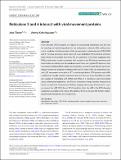Files in this item
Reticulons 3 and 6 interact with viral movement proteins
Item metadata
| dc.contributor.author | Tilsner, Jens | |
| dc.contributor.author | Kriechbaumer, Verena | |
| dc.date.accessioned | 2022-08-30T15:30:10Z | |
| dc.date.available | 2022-08-30T15:30:10Z | |
| dc.date.issued | 2022-08-20 | |
| dc.identifier | 281024762 | |
| dc.identifier | e7d3d509-0908-4ae6-b949-f6f5a33f9498 | |
| dc.identifier | 85136454916 | |
| dc.identifier.citation | Tilsner , J & Kriechbaumer , V 2022 , ' Reticulons 3 and 6 interact with viral movement proteins ' , Molecular Plant Pathology , vol. Early View . https://doi.org/10.1111/mpp.13261 | en |
| dc.identifier.issn | 1464-6722 | |
| dc.identifier.other | ORCID: /0000-0003-3873-0650/work/117997179 | |
| dc.identifier.uri | https://hdl.handle.net/10023/25915 | |
| dc.description | Funding; This research was funded by the Science and Technology Facilities Council Programme (grant no. 14230008), a British Biotechnology and Biological Sciences Research Council (grant no. BB/J004987/1 to Professor Chris Hawes), and a Vice-Chancellors Research Fellowship to V.K. Parts of this work were funded by the U.K. Biotechnology and Biomedical Sciences Research Council (BBSRC) grant BB/M007200/1 to J.T. Work in J.T.'s laboratory is supported by the Scottish Government's Rural and Environment Science and Analytical Services Division (RESAS). | en |
| dc.description.abstract | Plant reticulon (RTN) proteins are capable of constricting membranes and are vital for creating and maintaining tubules in the endoplasmic reticulum (ER), making them prime candidates for the formation of the desmotubule in plasmodesmata (PD). RTN3 and RTN6 have previously been detected in an Arabidopsis PD proteome and have been shown to be present in primary PD at cytokinesis. It has been suggested that RTN proteins form protein complexes with proteins in the PD plasma membrane and desmotubule to stabilize the desmotubule constriction and regulate PD aperture. Viral movement proteins (vMPs) enable the transport of viruses through PD and can be ER-integral membrane proteins or interact with the ER. Some vMPs can themselves constrict ER membranes or localize to RTN-containing tubules; RTN proteins and vMPs could be functionally linked or potentially interact. Here we show that different vMPs are capable of interacting with RTN3 and RTN6 in a membrane yeast two-hybrid assay, coimmunoprecipitation, and Förster resonance energy transfer measured by donor excited-state fluorescence lifetime imaging microscopy. Furthermore, coexpression of the vMP CMV-3a and RTN3 results in either the vMP or the RTN changing subcellular localization and reduces the ability of CMV-3a to open PD, further indicating interactions between the two proteins. | |
| dc.format.extent | 8 | |
| dc.format.extent | 1349752 | |
| dc.language.iso | eng | |
| dc.relation.ispartof | Molecular Plant Pathology | en |
| dc.subject | Endoplasmic reticulum | en |
| dc.subject | FRET-FLIM | en |
| dc.subject | Plasmodesmata | en |
| dc.subject | Protein-protein interaction | en |
| dc.subject | Reticulon | en |
| dc.subject | Viral movement protein | en |
| dc.subject | QR355 Virology | en |
| dc.subject | SB Plant culture | en |
| dc.subject | NDAS | en |
| dc.subject.lcc | QR355 | en |
| dc.subject.lcc | SB | en |
| dc.title | Reticulons 3 and 6 interact with viral movement proteins | en |
| dc.type | Journal article | en |
| dc.contributor.sponsor | BBSRC | en |
| dc.contributor.institution | University of St Andrews. School of Biology | en |
| dc.contributor.institution | University of St Andrews. Centre for Biophotonics | en |
| dc.contributor.institution | University of St Andrews. Biomedical Sciences Research Complex | en |
| dc.identifier.doi | 10.1111/mpp.13261 | |
| dc.description.status | Peer reviewed | en |
| dc.identifier.grantnumber | BB.M007200/1 | en |
This item appears in the following Collection(s)
Items in the St Andrews Research Repository are protected by copyright, with all rights reserved, unless otherwise indicated.

